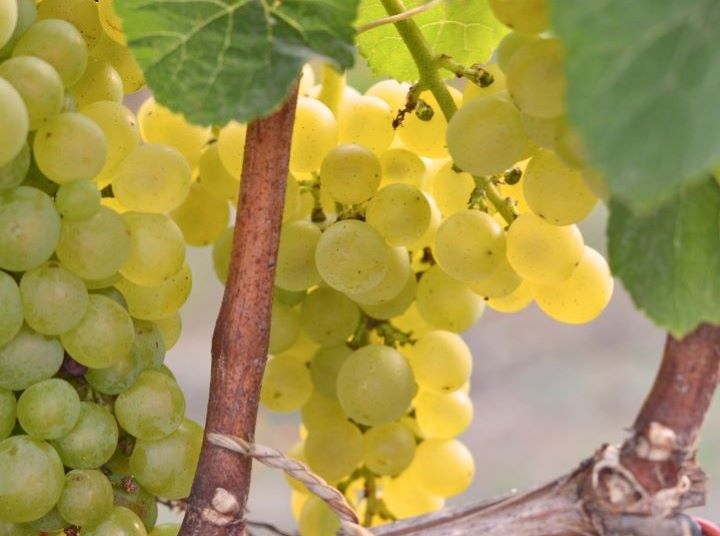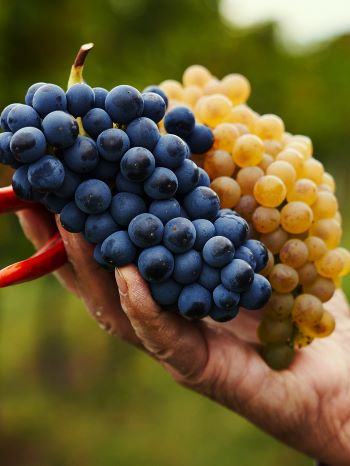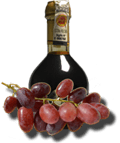The white Trebbiano grape is one of the world's oldest and most successful grape varieties. It is not only used for white wine, but also for the production of brandy and spirits. Besides that it is one of the most important grape varieties for the production of balsamic vinegar along with the Lambrusco grapes.

- Definition of Trebbiano
- Characteristics and flavour
- Trebbiano as a wine
- Trebbiano in balsamic vinegar
- Trebbiano in brandy
Trebbiano is a light-coloured grape variety that has spread and taken root all over Italy: It can be found in Tuscany, Romagna, Abruzzo, Lazio and Umbria. When we speak of the Trebbiano grape, it is not really accurate to do so. It is rather a collective term that includes about 15 different grape varieties. The most famous and successful Trebbiano varieties are as follows:
- Trebbiano Toscana (French: Ugni Blanc/St. Émilion)
- Trebbiano d'Abruzzo
- Trebbiano di Lugana
- Trebbiano Rubicone
- Trebbiano di Soave
- Trebbiano Modenese
- Trebbiano Romagnolo
- Trebbiano Spoletino
- Trebbiano di Spagna (also known as Trebbianino)
Vine explorer speak in the case of Trebbiano of a group rather than a family, because almost all the varieties are not descended from a common parent. In 2001, the results of a genetic analysis were published, which showed that there was just little family relationship between the many Trebbiano varieties. One reason for the similarity in the names dates back to the Middle Ages, when a number of white wine varieties were given the same name because of their popularity, even though they were not genetically related. Petrus de Crescenzi, for example, described Trebbiano as noble and persistent in 1303. In fact, the characteristics and flavours of the various grapes that bear the name Trebbiano are still very similar today.
The grapes of the Trebbiano grape are white-golden-yellow in colour. They ripen late and are particularly frost-resistant. It also adapts well to different climatic conditions and wine-growing methods. The Trebbiano grape is therefore very vigorous and productive, giving it a high yield. The taste of Trebbiano is characterised by a relatively low fructose content and a strong acidity. Trebbiano wines have both fruity and spicy aromas, reminiscent of apples, pears, citrus fruits, apricots and melon, but also of pine branches and sage.
Main uses of the Trebbiano grape for blending wines
Trebbiano wine is rarely vinified as a single variety and is often blended, due to the diversity of varieties. Thanks to its acidity and low alcohol content, it is a good complement to southern white wines, which are much higher in alcohol and lower in acidity. In Puglia, for example, the Malvasia grape is often used together with Trebbiano in many cuvées. Other famous Trebbiano wines include Frascati, from the area around Rome, and Orvieto, from Umbria, which is also made from Trebbiano grapes. Further north, in Veneto, the grapes are blended with Garganega to make Soave. In rare cases, the grape is also grown as a single variety. One of the best known and most popular wines is the Veneto Lugana, which is mainly made from Trebbiano di Lugana.
Trebbiano (di Spagna) as a selected grape for Aceto Balsamico Tradizionale
In the Modena and Reggio Emilia area, Trebbiano is one of the most important grape varieties for the production of Aceto Balsamico. It is even considered the queen grape in the vinegar factory and is one of the seven selected grape varieties allowed for the production of a traditional balsamic vinegar (besides Lambrusco, Ancellotta, Berzemino, Sauvignon blanc, Sgavetta and Occio di Gatta). In the production process, the grapes are first cooked to obtain the grape must. The must is then fermented and aged in wooden barrels for at least twelve years before it can be called Aceto Balsamico Tradizionale.
Although the name suggests that it is mainly the Trebbiano Modenese variety that is used to make balsamic vinegar, it is actually another variety with a less obvious name: Trebbiano di Spagna - also known as Trebbianini. As the name suggests, it originated in Spain and was imported to Italy in the 17th century by Francesco I° d'Este, the Duke of Modena. He particularly appreciated the white wine made from the grapes, which reminded him of the well-known Trebbiano wine from the hills and plains around Modena, and gave the grape the name "Trebbiano di Spagna".

The grape must from which a balsamic vinegar is made is usually a mixture of different grape varieties. Trebbiano di Spagna is now one of the most commonly used grapes for the production of balsamic vinegar, along with various Lambrusco varieties. Trebbiano is also used to make single-varietal balsamic vinegars. These are made from 100% Trebbiano grape must. The Trebbiano grape was almost extinct in Emilia-Romagna after the Second World War. Thanks to the acetias of the region, some "islands" of Trebbiano di Spagna have survived. One of these islands is a piece of land in Rubbiara di Nonantola belonging to the Pedroni family. They have been growing Trebbiano di Spagna for generations and use the grapes to make their Aceto Balsamico Tradizionale. Most of the time it is used as a single variety and not mixed with other grape must.
Italo Pedroni inherited it from his ancestors along with the old Osteria and continues to live his ancestors' passion for balsamic vinegar. In addition to Trebbiano di Spagna, he also uses other traditional Trebbiano varieties, such as Trebbiano di Ruggine, which other producers often discard because of their low yields. On the other hand, other producers in the area swear by Trebbiano di Spagna. It is one of the preferred varieties for the balsamic vinegar of Acetaia Malpighi and the balsamic vinegar of La Secchia. Unlike the Pedroni family, they usually mix the must with Lambrusco grapes.
By the way: There is a Consortia for the protection of balsamic vinegars. They check that the production of traditional balsamic vinegar complies with the regulations. Of course, they also pay attention to the selection of the grapes. Only then can the balsamic vinegar be called Traditional.
Trebbiano grape variety for the world's most famous brandy: Cognac
The Trebbiano grape is also widely used outside Italy, particularly in France. In the 14th century, the Trebbiano grape variety from Tuscany was exported to France at the time of the papal seat of Avignon. There it was given the name "Ugni Blanc" (also known as "St. Émilion") and cultivated first in Provence, then in Languedoc and finally in Charente-Maritime, where it still holds a privileged place. Although simple wines are also produced in Gascony, the grape is mainly used to make low-alcohol base wines that are distilled into brandies such as Cognac and Armagnac.
The Trebbiano grape has also made it across the pond. In Mexico, the grapes are used to make brandy, and Trebbiano grapes are also grown in Argentina and Uruguay. Trebbiano is one of the most important grape varieties in the world in terms of area under cultivation.
Trebbiano represents diversity and tradition
More than any other grape variety, Trebbiano represents diversity and tradition. Even though there is little relationship between the varieties, the name Trebbiano has become established and has given rise to a variety of grapes that have been used to make a wide range of specialities, from wine to coganc and balsamic vinegar. Trebbiano can be considered a "global" vine, as it is now found in many countries. However, it is in Italy that the Trebbiano grape became famous, and since then it has been inextricably linked to the country's tradition and culture, reflected above all in a traditional balsamic vinegar.


Cooking with Traditional Balsamic Vinegar
Meesha Halm, 96 pages
$ (EN) 18,90
Order today!